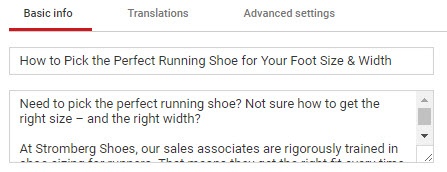Does Video Localization Really Increase SEO? Yes – Here Are 3 Ways

What Exactly Are Subtitles for the Deaf & Hard-of-Hearing (SDH)?
July 5, 2017
What Are Interactive Videos? Do They Affect Multimedia Localization?
July 19, 2017Video localization allows you and your clients to reach a global marketplace – but it can also help that marketplace find you, by increasing search engine optimization, also known by its acronym, SEO. Effectively, translating your videos can help bump up your search result rankings, meaning that clients find you first when they search for your products or services. But only if you know how to do it properly.
This post will look at how a strategy to translate your online video content can increase SEO.
[Average reading time: 4 minutes]
It all begins with transcription & closed captioning
Search engine optimization (SEO) is the process of making your online content – web pages, videos, or anything else that’s on the web – more likely to be listed in Google search results. On a very simplistic level, the primary way to increase SEO is to make sure your page contains the terms for which users will search. Secondarily, you can increase SEO by having other ranked sites link to your page, or by providing useful information or content so that visitors click a lot on your site. In general, the idea is to indicate to Google that your site is authoritative, or useful to your audience.
And of course, one of the ways to increase SEO on a page is to add video content to it, since videos increase user engagement – people click more generally on sites that have them, and spend time on the sites watching them. Moreover, the way that the video content is added can increase SEO as well – but video has an inherent drawback in this regard. Google can analyze the text on a page and embedded into graphics, but it can’t do so with any audio or video content. You can have thrilling videos with professional voice-over, but Google “reads” none of them.
This is where transcription comes in. Transcribing your video’s voice-over track is a cost-effective and rapid way to increase SEO, by turning elements that Google can’t read (like voice-over audio) into text that it can access. You can add the transcription right into the Description field of your video’s YouTube page, as you can see in the picture that follows.

Time-coding that text and adding it as closed captions is an even better way to increase SEO, since Google read this new metadata as an additional source of content. On top of that, closed captioning allows more users (in particular those who are deaf or hard-of-hearing) to access your videos and finish watching them, both of which factor heavily into Google’s ranking. Making the videos accessible is already a boost to your audience engagement, but this in turns boosts your SEO, which in turn boosts your audience engagement once more… you get the idea.
Subtitling & localization – the SEO multiplier
Yes, English is still the most widely used language on the internet. But that’s not the whole story – while internet usage in English is growing by double digits, usage in Chinese, Spanish, and Russian is increasing in orders of ten. For example, according to Internet World Stats, the number of English-language internet users grew by 576.4% from 2000 to 2017 – but Arabic-language usage grew by 6,805.9% during this same period. And remember that non-English users also live in the US – for example, providing Japanese video translations can help you increase retention (not to mention brand awareness and goodwill) in the Japanese-American community, which in turn boosts your SEO.
Wherever they are, reaching these non-English-speaking users requires translating your content – and optimizing for SEO into those languages. There are three ways to do this as part of the localization workflow.
- Translate your metadata. This is all the fields you fill in when uploading a video – the title, description (where your transcript should be already), and even the video filename.
- Use local keywords when you translate. Make sure to coordinate this with your in-country marketing video translation lead or digital business manager. Remember that it’s OK for your video transcription to differ from your exact voice-over if it helps SEO.
- Subtitle for the deaf and hard-of-hearing. Those captions you created for the English-language market? Translate them into subtitles for the deaf and hard-of- hearing (making sure to add the subs content). Not only does this create more metadata for Google to scan, but it also increases accessibility for better audience experience, video engagement – and increased SEO.
One more tip: even though you’ll be creating a language-specific instance of each video with localized metadata, make sure to upload all the different language SDH files to each video instance. That way, users can select their preferred language if they reach your page in a different locale. For example, a Chinese tourist in Berlin will probably land on your German video (because of their search locale) – but he or she will be able to choose the Chinese subtitling option. This, of course, will increase your engagement stats, and your SEO.
It’s all about the text
Remember that the key is to translate text elements associated with the video – you could do an amazing lip-sync dubbing of your online marketing spots, for example, but if that content doesn’t make it into the description field, or into a complementary SDH file, it’s not doing anything for your SEO directly. Make sure to take this text into account as part of larger localization plan, especially if you’ll also localize the voice-over, video titles, or any other video elements. Planning ahead is the key to boosting your SEO, as well as your localization ROI.

